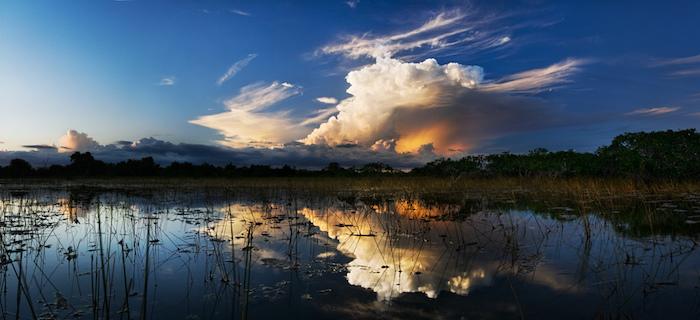
To improve the health of Everglades National Park, more clean, fresh water is needed to flow through the river of grass, according to the Everglades Coalition/NPS, Brian Call
An ambitious, four-year approach to improving the health of Everglades National Park, one that requires an influx of clean, fresh water, has been outlined to the participants of the annual Everglades Coalition conference.
Sea-level rise is viewed as a threat to the Everglades ecosystem, as it leads to the salinization of groundwater and the soils. But another problem facing the national park and its surrounding communities is toxic algae blooms. With that in mind, organizers of the conference that opened Friday called on state and federal leaders to send clean, fresh water south to the park.
Under a program referred to as Three Estuaries, One Solution, they said fresh water flowing through the park and into Florida Bay is needed to alleviate harmful Lake Okeechobee discharges from covering the Caloosahatchee and St. Lucie estuaries with toxic algae and polluting public beaches.
At the start of the conference, the coalition released a four-year roadmap highlighting restoration priorities for President-elect Donald Trump and Florida Governor Rick Scott, including specific opportunities for project funding, new infrastructure, and the timely completion of projects that maximize benefits to the greater Everglades ecosystem.
“Florida has a serious and ongoing water crisis,” said Cara Capp, national co-chair for the Everglades Coalition and Everglades restoration program manager for the National Parks Conservation Association. “Three estuaries are in crisis and there is one solution – Everglades restoration. We must have Everglades champions in federal, congressional and state-led leadership roles, from the Department of Interior to the South Florida Water Management District.
"We must also have a robust financial commitment that includes fulfilling the Central Everglades Restoration Plan (CERP) vision of at least $200 million per year from both our state and federal partners to advance the planning, construction and completion of critical restoration projects within the next four years.”
According to NPCA, restoring the Everglades is viewed as the world’s largest ecosystem restoration project and the past year has yielded significant restoration successes. These include congressional authorization of the Central Everglades Plan and breaking ground on the next 2.6 miles of bridging along Tamiami Trail, and starting construction of the C-43 West Basin Reservoir.
The coalition’s restoration roadmap for federal and state leaders provides a detailed list of restoration goals that can be achieved within the next four years including:
- Support Florida Senate President Joe Negron’s plan to purchase 60,000 acres of land south of Lake Okeechobee and expedite planning of the Everglades Agricultural Area (EAA) project.
- Maintain strong bipartisan support and secure financial commitment of $200 million per year from federal and state partners. Doing so will advance planning and projects as outlined in the CERP to achieve the significant economic and ecological benefits of Everglades restoration.
- Promote and continue the 65-year-old partnership between the U.S. Fish & Wildlife Service and the South Florida Water Management District (SFWMD). Allocate funds to control invasive species in the Arthur R. Marshall Loxahatchee National Wildlife Refuge to ensure the long-term viability of the refuge, safeguard wildlife and protect the integrity of the remaining Everglades ecosystem.
- Complete the next 2.6-miles of bridging along Tamiami Trail by 2019. Prioritize planning and appropriations to complete the rest of the 2.9 miles of bridging with groundbreaking by 2018.
“The Everglades Coalition stands in support of Senator Negron’s plan to purchase 60,000 acres of land south of Lake Okeechobee in the Everglades Agricultural Area, and to advance project planning that will send clean water south,” said Mike Baldwin, state co-chair for the Everglades Coalition and vice president of the “Ding” Darling Wildlife Society, the friends group of the J. N. “Ding” Darling National Wildlife Refuge. “We believe this is an important and common-sense step in solving the water crisis that has been plaguing the Everglades and our estuaries.”
The Everglades provides drinking water to 8 million people. This internationally-unique ecosystem is the lifeblood of South Florida’s environment, economy and public health. However, this past year marked one of the worst for Florida’s estuaries. The Caloosahatchee and St. Lucie Rivers are inundated with polluted Lake Okeechobee releases while Florida Bay remains starved for more freshwater, NPCA said.
“By sending clean water south, as outlined in CERP in 2000, it is possible to restore some of the historic River of Grass,” said Ms. Capp. “Doing so will benefit jobs, ecology and quality of life in Florida.”
Other restoration challenges to be discussed during the 32nd annual conference, which wraps up Sunday with field trips, included protecting marine resources, safeguarding coastal communities from rising sea levels, recovering Everglades wildlife, producing clean energy that does not detract from restoration efforts, and protecting the future of the Arthur R. Marshall Loxahatchee National Wildlife Refuge from threats to evict federal partners.


 Support Essential Coverage of Essential Places
Support Essential Coverage of Essential Places






